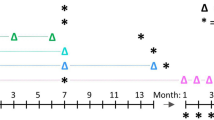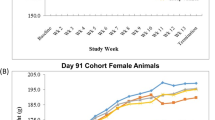Abstract
Gene transfer to lung has been hindered by inflammatory and immunological responses activated to the gene-transfer agent or transgene products. In prior work, adenovirus vector delivered to the lung with the cationic glucocorticoid, dexamethasone–spermine (DS) had improved targeting to conducting airway epithelium and reduced cellular infiltration. In this study, the effect of formulation on homologous adenovirus vector re-administration was studied in C57Bl/6 mice. Formulation of an adenovirus vector expressing LacZ with DS/dioleoylphosphatidylethanolamine (DOPE) delivered at day 0 allowed re-administration of adenovirus vector expressing alkaline phosphatase at day 21. Formulation with 3β [N-(N′, N′-dimethylaminoethane) carbamoy] cholesterol (DC-Chol) DC-cholesterol (DC-Chol))/DOPE or dexamethasone in the first dosing at day 0 resulted in moderate alkaline phosphatase expression at day 24. Neutralizing antibodies against adenovirus vector in serum at day 28 were greatly reduced by all three formulations in mice receiving a single dose of adenovirus at day 0. Also, homologous adenovirus vector re-administration at day 14 produced less neutralizing antibody at day 28 when adenovirus was formulated with DS/DOPE at day 0. The use of DS/DOPE at day 0 dramatically reduced CD4 and CD8 T-cell infiltration in mice receiving adenovirus at day 0 followed by vector re-administration at day 14. Transgene-specific T-cell activation was markedly reduced by the DC-Chol/DOPE formulation. Overall, DS/DOPE) facilitated homologous vector re-administration through a combination of liposomal and glucocorticoid mechanisms.
This is a preview of subscription content, access via your institution
Access options
Subscribe to this journal
Receive 12 print issues and online access
$259.00 per year
only $21.58 per issue
Buy this article
- Purchase on Springer Link
- Instant access to full article PDF
Prices may be subject to local taxes which are calculated during checkout






Similar content being viewed by others
References
Liu Q, Muruve DA . Molecular basis of the inflammatory response to adenovirus vectors. Gene Therapy 2003; 10: 935–940.
Yang Y, Li Q, Ertl HC, Wilson JM . Cellular and humoral immune responses to viral antigens create barriers to lung-directed gene therapy with recombinant adenoviruses. J Virol 1995; 69: 2004–2015.
Knowles MR, Hohneker KW, Zhou Z, Olsen JC, Noah TL, Hu PC et al. A controlled study of adenoviral-vector-mediated gene transfer in the nasal epithelium of patients with cystic fibrosis. N Engl J Med 1995; 333: 823–831.
Qiu C, De Young MB, Finn A, Dichek DA . Cationic liposomes enhance adenovirus entry via a pathway independent of the fiber receptor and alpha(v)-integrins. Hum Gene Therapy 1998; 9: 507–520.
Burrus JK, Matheson WD, Hong JS, Sorscher EJ, Balkovetz DF . Hepatocyte growth factor stimulates adenoviral-mediated gene transfer across the apical membrane of epithelial cells. J Gene Med 2004; 6: 624–630.
Mei YF, Lindman K, Wadell G . Two closely related adenovirus genome types with kidney or respiratory tract tropism differ in their binding to epithelial cells of various origins. Virology 1998; 240: 254–266.
Pickles RJ, McCarty D, Matsui H, Hart PJ, Randell SH, Boucher RC . Limited entry of adenovirus vectors into well-differentiated airway epithelium is responsible for inefficient gene transfer. J Virol 1998; 72: 6014–6023.
Coyne CB, Kelly MM, Boucher RC, Johnson LG . Enhanced epithelial gene transfer by modulation of tight junctions with sodium caprate. Am J Respir Cell Mol Biol 2000; 23: 602–609.
Parsons DW, Grubb BR, Johnson LG, Boucher RC . Enhanced in vivo airway gene transfer via transient modification of host barrier properties with a surface-active agent. Hum Gene Therapy 1998; 9: 2661–2672.
Crystal RG, McElvaney NG, Rosenfeld MA, Chu CS, Mastrangeli A, Hay JG et al. Administration of an adenovirus containing the human CFTR cDNA to the respiratory tract of individuals with cystic fibrosis. Nat Genet 1994; 8: 42–51.
Barouch DH, Santra S, Tenner-Racz K, Racz P, Kuroda MJ, Schmitz JE et al. Potent CD4+ T cell responses elicited by a bicistronic HIV-1 DNA vaccine expressing gp120 and GM-CSF. J Immunol 2002; 168: 562–568.
Hutchin ME, Pickles RJ, Yarbrough WG . Efficiency of adenovirus-mediated gene transfer to oropharyngeal epithelial cells correlates with cellular differentiation and human coxsackie and adenovirus receptor expression. Hum Gene Therapy 2000; 11: 2365–2375.
Bonsted A, Engesaeter BO, Hogset A, Maelandsmo GM, Prasmickaite L, Kaalhus O et al. Transgene expression is increased by photochemically mediated transduction of polycation-complexed adenoviruses. Gene Therapy 2004; 11: 152–160.
Melotti P, Nicolis E, Tamanini A, Rolfini R, Pavirani A, Cabrini G . Activation of NF-κB mediates ICAM-1 induction in respiratory cells exposed to an adenovirus-derived vector. Gene Therapy 2001; 8: 1436–1442.
Jooss K, Chirmule N . Immunity to adenovirus and adeno-associated viral vectors: implications for gene therapy. Gene Therapy 2003; 10: 955–963.
Chen D, Murphy B, Sung R, Bromberg JS . Adaptive and innate immune responses to gene transfer vectors: role of cytokines and chemokines in vector function. Gene Therapy 2003; 10: 991–998.
Look DC, Brody SL . Engineering viral vectors to subvert the airway defense response. Am J Respir Cell Mol Biol 1999; 20: 1103–1106.
Croyle MA, Chirmule N, Zhang Y, Wilson JM . Stealth’ adenoviruses blunt cell-mediated and humoral immune responses against the virus and allow for significant gene expression upon readministration in the lung. J Virol 2001; 75: 4792–4801.
Zhang JS, Liu F, Huang L . Implications of pharmacokinetic behavior of lipoplex for its inflammatory toxicity. Adv Drug Deliv Rev 2005; 57: 689–698.
Matsuse H, Kong X, Hu J, Wolf SF, Lockey RF, Mohapatra SS . Intranasal IL-12 produces discreet pulmonary and systemic effects on allergic inflammation and airway reactivity. Int Immunopharmacol 2003; 3: 457–468.
van Ginkel FW, McGhee JR, Liu C, Simecka JW, Yamamoto M, Frizzell RA et al. Adenoviral gene delivery elicits distinct pulmonary-associated T helper cell responses to the vector and to its transgene. J Immunol 1997; 159: 685–693.
Price A, Limberis M, Gruneich JA, Wilson JM, Diamond SL . Targeting viral-mediated transduction to the lung airway epithelium with the anti-inflammatory cationic lipid dexamethasone–spermine. Mol Therapy 2005; 12: 502–509.
Gruneich JA, Price A, Zhu J, Diamond SL . Cationic corticosteroid for nonviral gene delivery. Gene Therapy 2004; 11: 668–674.
Hoerr I, Obst R, Rammensee HG, Jung G . In vivo application of RNA leads to induction of specific cytotoxic T lymphocytes and antibodies. Eur J Immunol 2000; 30: 1–7.
Sakurai H, Sakurai F, Kawabata K, Sasaki T, Koizumi N, Huang H et al. Comparison of gene expression efficiency and innate immune response induced by Ad vector and lipoplex. J Control Release 2007; 117: 430–437.
Zeng X, Moore TA, Newstead MW, Deng JC, Lukacs NW, Standiford TJ . IP-10 mediates selective mononuclear cell accumulation and activation in response to intrapulmonary transgenic expression and during adenovirus-induced pulmonary inflammation. J Interferon Cytokine Res 2005; 25: 103–112.
Plank C, Mechtler K, Szoka Jr FC, Wagner E . Activation of the complement system by synthetic DNA complexes: a potential barrier for intravenous gene delivery. Hum Gene Therapy 1996; 7: 1437–1446.
Gao GP, Yang Y, Wilson JM . Biology of adenovirus vectors with E1 and E4 deletions for liver-directed gene therapy. J Virol 1996; 70: 8934–8943.
Bell P, Limberis M, Gao G, Wu D, Bove MS, Sanmiguel JC et al. An optimized protocol for detection of E. coli beta-galactosidase in lung tissue following gene transfer. Histochem Cell Biol 2005; 124: 77–85.
Miller RA . Immunodeficiency of aging: restorative effects of phorbol ester combined with calcium ionophore. J Immunol 1986; 137: 805–808.
Acknowledgements
This work was supported by National Institutes of Health Grant HL66565 and Cystic Fibrosis Foundation Grants D01IO and 5886, and P30 (DK047757). We thank Deirdre McMenamin and Regina Munden for invaluable assistance with animal work. Peter Bell and Di Wu are also gratefully acknowledged for expert morphology work and Roberto Calcedo, Jim Miller and Judith Franco are thanked for performing NAB assays. Finally, we express our thanks to the Penn Vector Core for providing AdV vectors.
Author information
Authors and Affiliations
Corresponding author
Rights and permissions
About this article
Cite this article
Price, A., Limberis, M., Wilson, J. et al. Pulmonary delivery of adenovirus vector formulated with dexamethasone–spermine facilitates homologous vector re-administration. Gene Ther 14, 1594–1604 (2007). https://doi.org/10.1038/sj.gt.3303031
Received:
Revised:
Accepted:
Published:
Issue Date:
DOI: https://doi.org/10.1038/sj.gt.3303031
Keywords
This article is cited by
-
Current advances in developing cationic lipid-based nanoparticles as a vehicle for improving adenoviral gene delivery
Journal of Pharmaceutical Investigation (2016)
-
Advances in Cell and Gene-based Therapies for Cystic Fibrosis Lung Disease
Molecular Therapy (2012)
-
Readministration of helper-dependent adenoviral vectors to mouse airway mediated via transient immunosuppression
Gene Therapy (2011)
-
Augmentation of adenovirus 5 vector-mediated gene transduction under physiological pH conditions by a chitosan/NaHCO3 solution
Gene Therapy (2011)
-
Analysis of plasma protein adsorption onto DC-Chol-DOPE cationic liposomes by HPLC-CHIP coupled to a Q-TOF mass spectrometer
Analytical and Bioanalytical Chemistry (2010)



